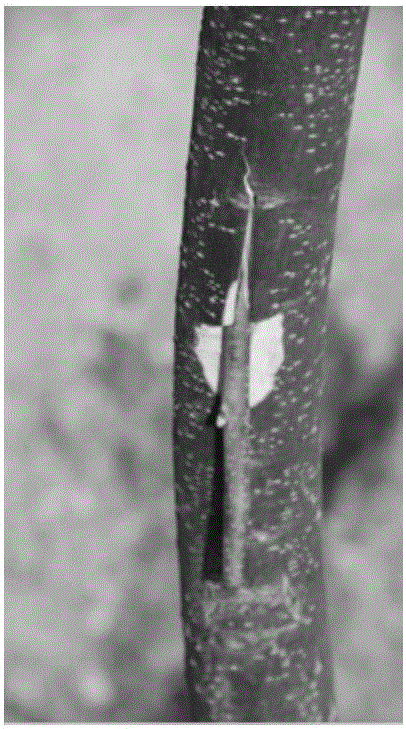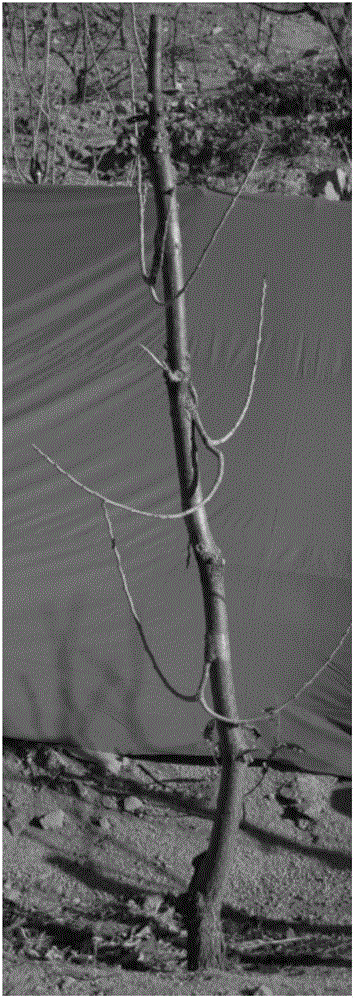Chestnut tree grafting method
A technology of chestnut trees and chestnuts, which is applied in the field of plant cultivation, can solve the problems that the tree body is easy to grow wildly, the new shoots are easy to be broken by the wind, and the efficiency is low, so as to solve the problem of tree body growth, improve tree body illumination, and save grafting The effect of labor
- Summary
- Abstract
- Description
- Claims
- Application Information
AI Technical Summary
Problems solved by technology
Method used
Image
Examples
Embodiment 1
[0056] 1. Rootstock selection:
[0057] Choose robust growth, more than 5cm in thickness, about 3m in height (the thickness at 2m needs to be more than 3cm in thickness), good grafting compatibility, and disease-free chestnut plants as rootstocks.
[0058] 2. Scion selection:
[0059] Select annual chestnut branches with good quality, high yield, about 30 cm in length and 0.5 cm to 1.0 cm in thickness as scions.
[0060] 3. Rootstock treatment:
[0061] Choose the straightest and thickest branch as the trunk, and choose to leave the trunk more than 2m; use a quick saw or scissors to thin out all the remaining branches.
[0062] Treated rootstocks such as figure 1 shown.
[0063] 4. Scion cutting:
[0064] Use a grafting knife to cut the chestnut scion into a horse-ear shape with a cut surface of 8cm to 10cm in length, cut one knife on the back and two sides each, and cut it into a slanted tip.
[0065] 5. Rootstock cutting:
[0066] Make a horizontal cut on the smooth p...
Embodiment 2
[0079] 1. Rootstock selection:
[0080] Choose robust growth, more than 8cm in thickness, more than 5m in height (thickness at 3m must be more than 3cm), good grafting compatibility, and disease-free chestnut plants as rootstocks.
[0081] 2. Scion selection:
[0082] Select annual chestnut branches with good quality, high yield, 25 cm in length and 0.5 cm to 1.0 cm in thickness as scions.
[0083] 3. Rootstock treatment:
[0084] Choose the straightest and thickest branch as the trunk, and choose to leave the trunk more than 3m; use a quick saw or scissors to thin out all the remaining branches.
[0085] 4. Scion cutting:
[0086] Use a grafting knife to cut the chestnut scion into a horse-ear shape with a cut surface of 8cm to 10cm in length, cut one knife on the back and two sides each, and cut it into a slanted tip.
[0087] 5. Rootstock cutting:
[0088] Make a horizontal cut on the smooth part of the rootstock, reaching to the xylem; at the lower end of the cross cu...
Embodiment 3
[0100] 1. Rootstock selection:
[0101] Choose robust growth, more than 7cm in thickness, about 4m in height (the thickness at 2.5m must be more than 3cm), good grafting compatibility, and disease-free chestnut plants as rootstocks.
[0102] 2. Scion selection:
[0103] Select annual chestnut branches with good quality, high yield, 25 cm in length and 0.5 cm to 1.0 cm in thickness as scions.
[0104] 3. Rootstock treatment:
[0105] Choose the straightest and thickest branch as the trunk, and choose to leave the trunk more than 2.5m; use a quick saw or scissors to thin out all the remaining branches.
[0106] 4. Scion cutting:
[0107] Use a grafting knife to cut the chestnut scion into a horse-ear shape with a cut surface of 8cm to 10cm in length, cut one knife on the back and two sides each, and cut it into a slanted tip.
[0108] 5. Rootstock cutting:
[0109] Make a horizontal cut on the smooth part of the rootstock, reaching to the xylem; at the lower end of the cros...
PUM
| Property | Measurement | Unit |
|---|---|---|
| Length | aaaaa | aaaaa |
| Roughness | aaaaa | aaaaa |
| Roughness | aaaaa | aaaaa |
Abstract
Description
Claims
Application Information
 Login to View More
Login to View More - R&D
- Intellectual Property
- Life Sciences
- Materials
- Tech Scout
- Unparalleled Data Quality
- Higher Quality Content
- 60% Fewer Hallucinations
Browse by: Latest US Patents, China's latest patents, Technical Efficacy Thesaurus, Application Domain, Technology Topic, Popular Technical Reports.
© 2025 PatSnap. All rights reserved.Legal|Privacy policy|Modern Slavery Act Transparency Statement|Sitemap|About US| Contact US: help@patsnap.com



